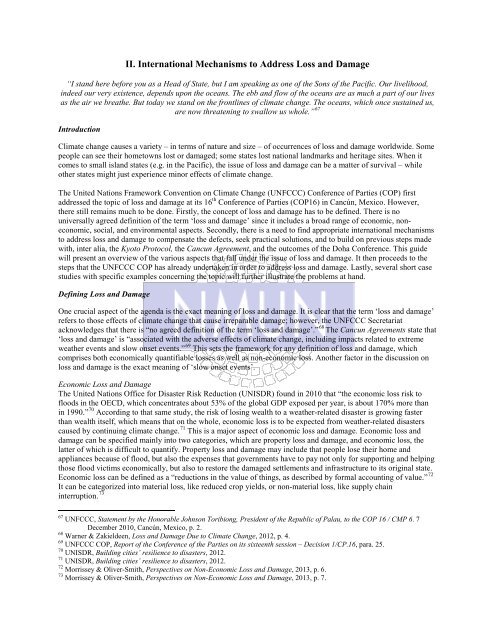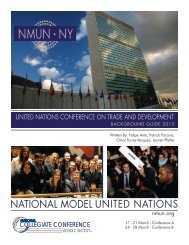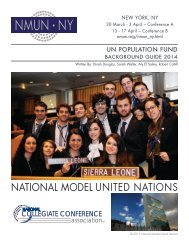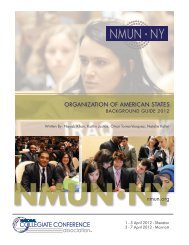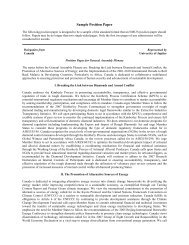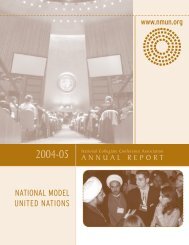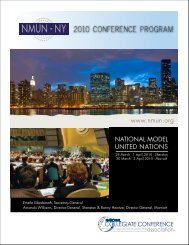NMUN • KOREA - National Model United Nations
NMUN • KOREA - National Model United Nations
NMUN • KOREA - National Model United Nations
You also want an ePaper? Increase the reach of your titles
YUMPU automatically turns print PDFs into web optimized ePapers that Google loves.
II. International Mechanisms to Address Loss and Damage<br />
“I stand here before you as a Head of State, but I am speaking as one of the Sons of the Pacific. Our livelihood,<br />
indeed our very existence, depends upon the oceans. The ebb and flow of the oceans are as much a part of our lives<br />
as the air we breathe. But today we stand on the frontlines of climate change. The oceans, which once sustained us,<br />
are now threatening to swallow us whole.” 67<br />
Introduction<br />
Climate change causes a variety – in terms of nature and size – of occurrences of loss and damage worldwide. Some<br />
people can see their hometowns lost or damaged; some states lost national landmarks and heritage sites. When it<br />
comes to small island states (e.g. in the Pacific), the issue of loss and damage can be a matter of survival – while<br />
other states might just experience minor effects of climate change.<br />
The <strong>United</strong> <strong>Nations</strong> Framework Convention on Climate Change (UNFCCC) Conference of Parties (COP) first<br />
addressed the topic of loss and damage at its 16 th Conference of Parties (COP16) in Cancún, Mexico. However,<br />
there still remains much to be done. Firstly, the concept of loss and damage has to be defined. There is no<br />
universally agreed definition of the term ‘loss and damage’ since it includes a broad range of economic, noneconomic,<br />
social, and environmental aspects. Secondly, there is a need to find appropriate international mechanisms<br />
to address loss and damage to compensate the defects, seek practical solutions, and to build on previous steps made<br />
with, inter alia, the Kyoto Protocol, the Cancun Agreement, and the outcomes of the Doha Conference. This guide<br />
will present an overview of the various aspects that fall under the issue of loss and damage. It then proceeds to the<br />
steps that the UNFCCC COP has already undertaken in order to address loss and damage. Lastly, several short case<br />
studies with specific examples concerning the topic will further illustrate the problems at hand.<br />
Defining Loss and Damage<br />
One crucial aspect of the agenda is the exact meaning of loss and damage. It is clear that the term ‘loss and damage’<br />
refers to those effects of climate change that cause irreparable damage; however, the UNFCCC Secretariat<br />
acknowledges that there is “no agreed definition of the term ‘loss and damage’.” 68 The Cancun Agreements state that<br />
‘loss and damage’ is “associated with the adverse effects of climate change, including impacts related to extreme<br />
weather events and slow onset events.” 69 This sets the framework for any definition of loss and damage, which<br />
comprises both economically quantifiable losses as well as non-economic loss. Another factor in the discussion on<br />
loss and damage is the exact meaning of ‘slow onset events’.<br />
Economic Loss and Damage<br />
The <strong>United</strong> <strong>Nations</strong> Office for Disaster Risk Reduction (UNISDR) found in 2010 that “the economic loss risk to<br />
floods in the OECD, which concentrates about 53% of the global GDP exposed per year, is about 170% more than<br />
in 1990.” 70 According to that same study, the risk of losing wealth to a weather-related disaster is growing faster<br />
than wealth itself, which means that on the whole, economic loss is to be expected from weather-related disasters<br />
caused by continuing climate change. 71 This is a major aspect of economic loss and damage. Economic loss and<br />
damage can be specified mainly into two categories, which are property loss and damage, and economic loss, the<br />
latter of which is difficult to quantify. Property loss and damage may include that people lose their home and<br />
appliances because of flood, but also the expenses that governments have to pay not only for supporting and helping<br />
those flood victims economically, but also to restore the damaged settlements and infrastructure to its original state.<br />
Economic loss can be defined as a “reductions in the value of things, as described by formal accounting of value.” 72<br />
It can be categorized into material loss, like reduced crop yields, or non-material loss, like supply chain<br />
interruption. 73<br />
67 UNFCCC, Statement by the Honorable Johnson Toribiong, President of the Republic of Palau, to the COP 16 / CMP 6. 7<br />
December 2010, Cancún, Mexico, p. 2.<br />
68 Warner & Zakieldeen, Loss and Damage Due to Climate Change, 2012, p. 4.<br />
69 UNFCCC COP, Report of the Conference of the Parties on its sixteenth session – Decision 1/CP.16, para. 25.<br />
70 UNISDR, Building cities’ resilience to disasters, 2012.<br />
71 UNISDR, Building cities’ resilience to disasters, 2012.<br />
72 Morrissey & Oliver-Smith, Perspectives on Non-Economic Loss and Damage, 2013, p. 6.<br />
73 Morrissey & Oliver-Smith, Perspectives on Non-Economic Loss and Damage, 2013, p. 7.


